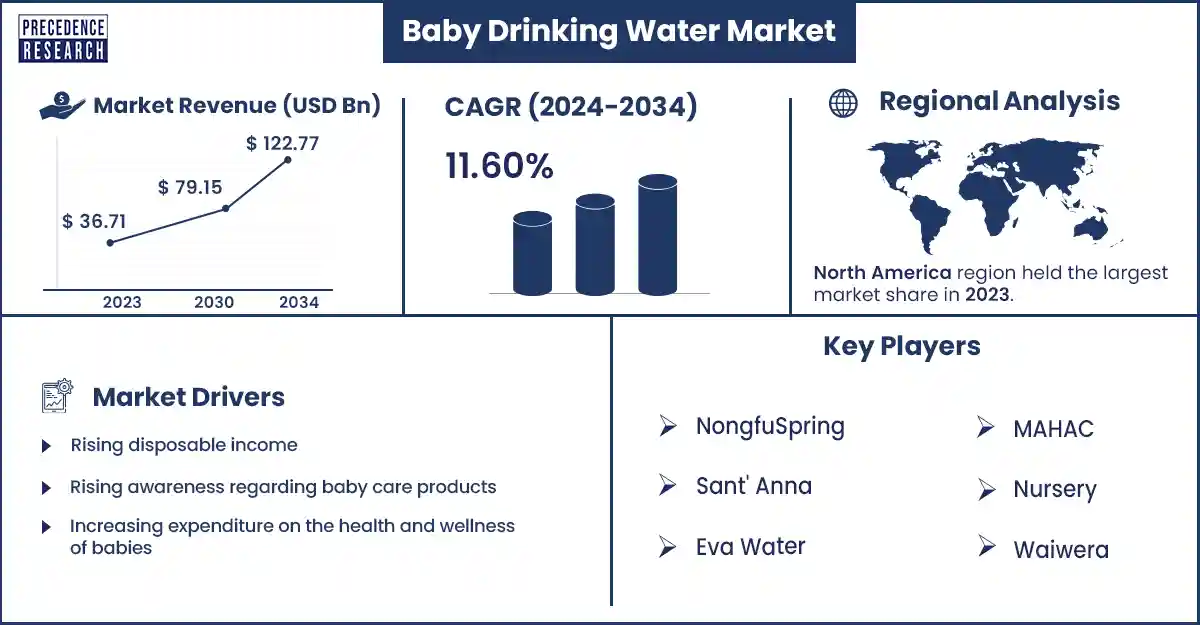Baby Drinking Water Revenue to Attain USD 110.01 Bn by 2033
Baby Drinking Water Revenue and Trends
The global baby drinking water market was valued at USD 40.97 billion in 2024 and is projected to reach around USD 110.01 billion by 2033, expanding at a CAGR of 11.60% from 2024 to 2033. The demand for baby drinking water is increasing due to the lack of drinkable water for babies. Additionally, rising health awareness among parents and the benefits of baby drinking water are driving the market growth.

Market Overview
Baby drinking water is specifically designed for infants and is free of fluoride, chlorine, and other heavy metals that can be dangerous to the health of the babies. The global baby drinking water market is driven by the increasing awareness regarding the ill effects of drinking contaminated water, rising disposable income, rising awareness regarding baby care products, increasing expenditure on the health and wellness of babies, and lack of suitable drinking water for babies.
The high sodium and fluoride content in regular drinking water may alter an infant’s ability to absorb nutrition from food and may hamper its development. Baby drinking water protects babies from any disorder that may occur due to the consumption of contaminated water. The rising incidences of diseases caused by contaminated water are boosting the demand for baby drinking water across the globe.
According to data published by the World Health Organization (WHO), around 443,832 children below 5 years of age die each year due to diarrhea caused by the consumption of impure water.
Highlights of the Baby Drinking Water Market Report
- Based on type, the pure water segment led the market in 2023. This is mainly due to the rising awareness among parents about the negative health impact on infants associated with the consumption of regular drinking water. Pure drinking water is free of sulfate and sodium, which is beneficial for infant’s immune system.
- On the basis of age, the 12-24 months segment dominated the market in 2023. An infant’s immune system matures after 1 year of age. Thus, they require pure water. This, in turn, boosts the demand for baby drinking water.
Baby Drinking Water Market Trends
- Rising health awareness: The increasing health concerns regarding the consumption of normal drinking water lead to the growing demand for baby drinking water. Many market players are expanding their production facilities and product portfolios, which help to fulfill the consumers' varying demands for infant drinking water.
- Increasing demand for natural and organic products: Rising health awareness has shifted consumer preferences toward products containing natural and organic materials and ingredients. This has led to a high demand for baby water with natural purity and clean labels.
- Rising disposable income: Consumers' increasing disposable income encourages them to spend on healthy products that are beneficial for the human body. This also raises parents' willingness to spend more money on their child's health and safety.
- Adoption of sustainable packaging: Rising environmental concerns have led to the shift to sustainable packaging throughout various industries. This also influences the adoption of biodegradable materials in bottles, which is expected to generate immense opportunities in the market.
Regional Insights
In 2023, North America led the baby drinking water market. The region’s dominance is mainly attributed to the high awareness about the health and wellness of infants among the parents. In addition, rising preference for specialty baby care products, increasing demand for infant formula, and rising healthcare spending contribute to regional market expansion.
Asia Pacific is anticipated to witness rapid growth in the market in the near future. This is mainly due to the rising birth rates in China and India. Moreover, rising health consciousness among people, scarcity of drinkable water in underdeveloped areas, and the rising demand for health and wellness products for infants are expected to boost the demand for baby drinking water, fueling the market growth in the region.
Baby Drinking Water Market Coverage
| Report Attribute | Key Statistics |
| Market Revenue in 2024 | USD 40.97 Billion |
| Market Revenue by 2033 | USD 110.01 Billion |
| CAGR | 11.60% from 2024 to 2033 |
| Quantitative Units | Revenue in USD million/billion, Volume in units |
| Largest Market | North America |
| Base Year | 2023 |
| Regions Covered | North America, Europe, Asia-Pacific, Latin America, and Middle East & Africa |
Market News
- In May 2024, Woodward’s Gripe water, an Ayurvedic formulation brand for babies, launched its latest campaign to celebrate the new mother and her baby. The main motive behind this campaign is to spread awareness among mothers about the wellbeing of child.
Segments Covered in the Report
By Type
- Pure Water
- Mineral Water
- Others
By Age
- 3-6 Months
- 7-12 Months
- 12-24 Months
Get this report to explore global market size, share, CAGR and trends, featuring detailed segmental analysis and an insightful competitive landscape overview@ https://www.precedenceresearch.com/checkout/1432
You can place an order or ask any questions, please feel free to contact at sales@precedenceresearch.com | +1 804 441 9344